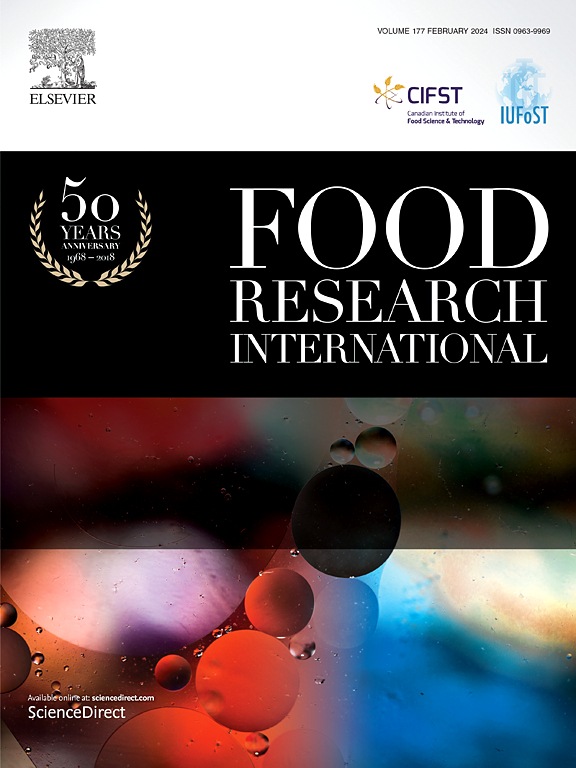Mechanisms of patulin biodegradation by Wickerhamomyces anomalus XL1 in apple juice
IF 7
1区 农林科学
Q1 FOOD SCIENCE & TECHNOLOGY
引用次数: 0
Abstract
Patulin (PAT), a mycotoxin primarily produced by Penicillium species, presents a serious food safety challenge due to its widespread occurrence and harmful health effects. Among current detoxification approaches, yeast-based degradation is particularly promising, offering high efficiency, environmental sustainability, and preservation of food quality—key attributes for industrial application. However, the enzymatic pathways involved and the potential for concurrent quality enhancement remain poorly understood. In this study, Wickerhamomyces anomalus XL1—selected from 15 yeast strains for its superior PAT-degrading capacity—completely eliminated 5 μg/mL PAT to undetectable levels (<0.06 μg/mL) within 24 h under optimal conditions (pH 3–7, 20–35 °C). Mechanistic analysis confirmed that degradation is mediated by intracellular enzymes, indicating an enzymatic rather than adsorptive mechanism. UPLC-Q-TOF/MS identified the major degradation products as non-toxic E/Z-ascladiol isomers. Importantly, XL1 demonstrated practical efficacy in both fresh and commercial apple juice, achieving complete PAT removal within 24 h. Additionally, it enhanced juice quality by increasing total phenolic content (from 243.25 to 397.17 mg/L) and enriching volatile aroma profiles through the synthesis of novel compounds. This dual functionality—efficient PAT detoxification and concurrent improvement of product quality—positions W. anomalus XL1 as a highly promising biological agent for industrial-scale food safety applications.

异常柳杉XL1在苹果汁中降解展霉素的机制
棒曲霉素(Patulin, PAT)是一种主要由青霉菌产生的真菌毒素,由于其广泛存在和对健康的有害影响,对食品安全构成了严重挑战。在目前的解毒方法中,以酵母为基础的降解尤其有前途,它提供了高效率、环境可持续性和食品质量的保存——这是工业应用的关键属性。然而,所涉及的酶的途径和潜在的并发质量提高仍然知之甚少。在本研究中,从15个酵母菌株中筛选出的具有优异PAT降解能力的Wickerhamomyces anomalus x_1,在最佳条件(pH 3-7, 20-35℃)下,在24 h内将5 μg/mL的PAT完全降解至0.06 μg/mL。机理分析证实,降解是由细胞内酶介导的,表明酶而不是吸附机制。UPLC-Q-TOF/MS鉴定主要降解产物为无毒的E/ z -戊二醇异构体。重要的是,XL1在新鲜和商业苹果汁中都显示出实际功效,在24小时内完全去除PAT。此外,它通过增加总酚含量(从243.25 mg/L增加到397.17 mg/L)和通过合成新化合物丰富挥发性香气谱来提高果汁品质。这种双重功能高效的PAT解毒和同时改善产品质量,使W. anomalus XL1成为工业规模食品安全应用中非常有前途的生物制剂。
本文章由计算机程序翻译,如有差异,请以英文原文为准。
求助全文
约1分钟内获得全文
求助全文
来源期刊

Food Research International
工程技术-食品科技
CiteScore
12.50
自引率
7.40%
发文量
1183
审稿时长
79 days
期刊介绍:
Food Research International serves as a rapid dissemination platform for significant and impactful research in food science, technology, engineering, and nutrition. The journal focuses on publishing novel, high-quality, and high-impact review papers, original research papers, and letters to the editors across various disciplines in the science and technology of food. Additionally, it follows a policy of publishing special issues on topical and emergent subjects in food research or related areas. Selected, peer-reviewed papers from scientific meetings, workshops, and conferences on the science, technology, and engineering of foods are also featured in special issues.
 求助内容:
求助内容: 应助结果提醒方式:
应助结果提醒方式:


